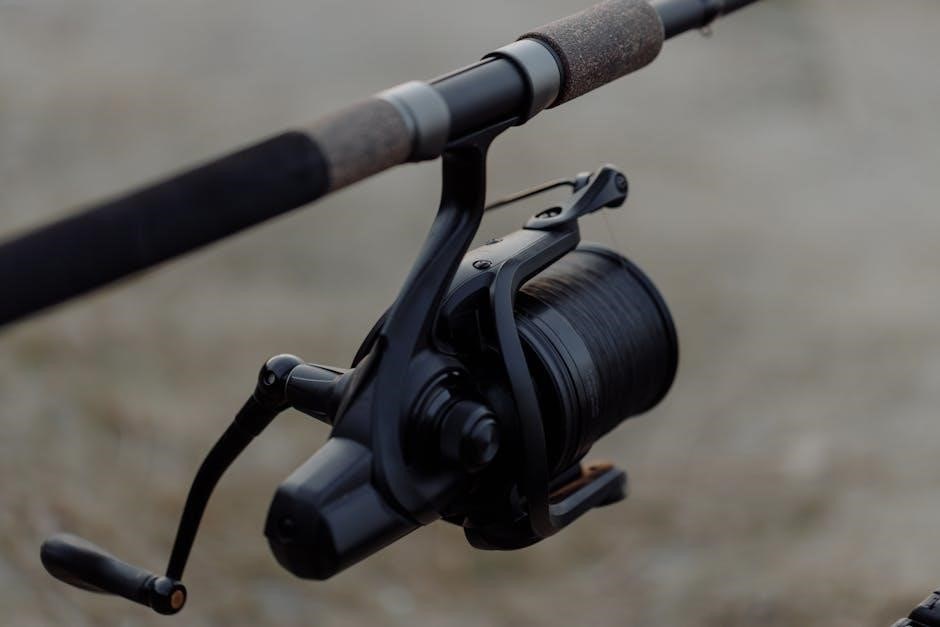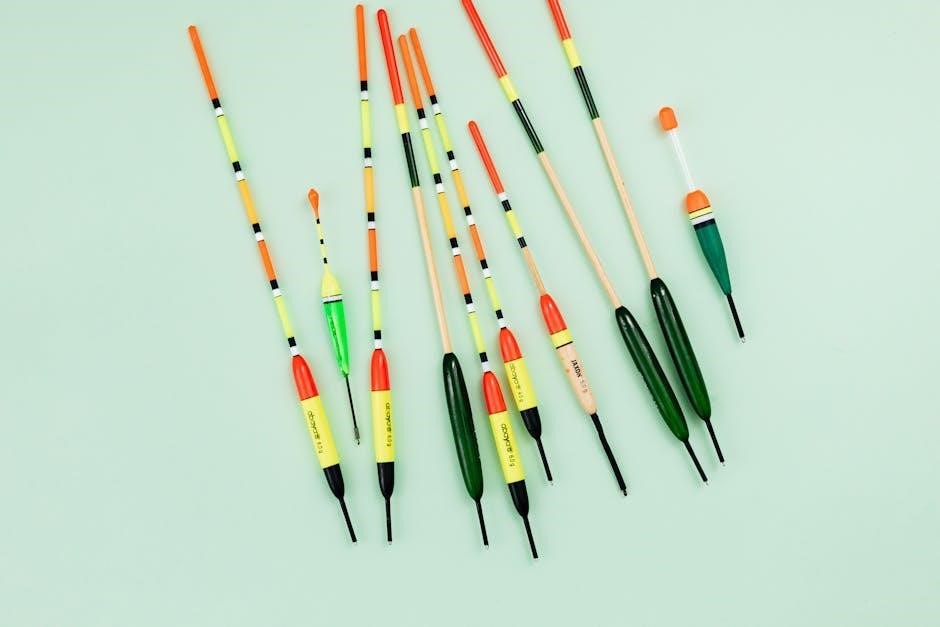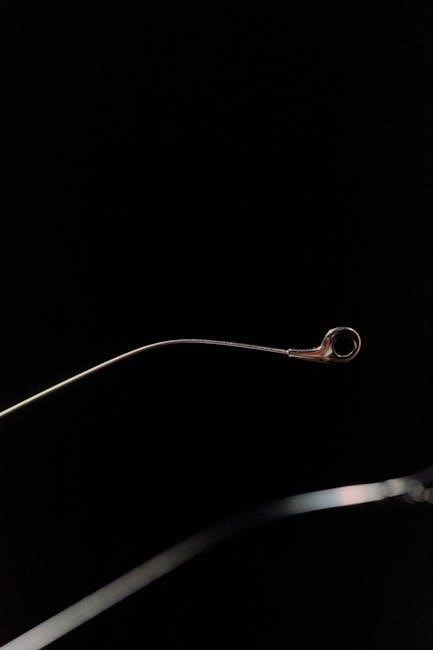Rod guides are essential components that direct the fishing line, reduce wear, and distribute force during casting and fighting fish. They enhance casting accuracy and sensitivity, with materials like ceramic, stainless steel, and titanium offering durability and smooth line flow. Choosing the right guides is crucial for optimal rod performance and fishing success;
1.1 What Are Rod Guides?
Rod guides, also known as eyelets, are circular or oval rings attached along the length of a fishing rod. They serve as pathways for the fishing line, directing it from the reel to the tip of the rod. Guides are typically made from materials like ceramic, stainless steel, or titanium, ensuring durability and smooth line flow. They come in various sizes and types, such as single-foot or double-foot designs, to suit different fishing techniques and rod styles. The quality of the guide frame and insert ring significantly impacts the rod’s performance, making them a critical component for anglers seeking precision and control during casting and fighting fish.
1.2 Importance of Rod Guides in Fishing

Rod guides play a vital role in enhancing fishing performance by directing the line accurately and reducing wear and tear. They distribute force during casting and fighting fish, preventing line damage and improving control. Guides also dissipate heat generated by friction, especially with heavy lines or strong drag settings, protecting both the line and rod. By minimizing line friction, they improve casting distance and sensitivity, allowing anglers to detect bites more effectively. Properly selected guides ensure smooth line flow, which is critical for precise casting and overall fishing success. Their role in maintaining rod balance and responsiveness makes them indispensable for anglers seeking optimal performance.
Anatomy of a Rod Guide
A rod guide consists of a frame, ring (insert), and foot, working together to direct the line, reduce wear, and distribute force during casting and fishing. Durable materials ensure smooth performance and longevity.
2.1 The Frame
The frame is the structural component of a rod guide, providing durability and stability. Made from materials like stainless steel, titanium, or ceramic, it ensures resistance to corrosion and wear. The frame’s design and material significantly impact the guide’s performance, affecting line flow and sensitivity. A sturdy frame is crucial for withstanding the forces exerted during casting and fighting fish, while lighter materials enhance sensitivity and reduce weight. Properly designed frames also contribute to smooth line transition, minimizing friction and preventing line damage. The frame’s strength and material quality are vital for maintaining the rod’s overall performance and longevity.
2.2 The Ring (Insert)
The ring, or insert, is a critical component of a rod guide, directly influencing line performance. Typically made from materials like ceramic, stainless steel, or titanium, it ensures smooth line flow and minimizes friction. The ring’s durability and resistance to wear are vital for maintaining consistent fishing performance. Its size and shape are carefully designed to match the line type and fishing technique, ensuring optimal casting distance and accuracy. A high-quality ring reduces line wear and tear, while its smooth surface prevents heat buildup from friction. The ring’s material and construction play a key role in enhancing sensitivity and overall fishing efficiency, making it a focal point of guide design.
2.3 The Foot
The foot is the base of the rod guide that attaches to the fishing rod, ensuring secure placement and alignment. It is typically made from durable materials like stainless steel or titanium, designed to withstand the stresses of fishing. The foot’s shape and size are crucial for proper wrapping and bonding to the rod blank, ensuring stability and preventing damage. A well-designed foot enhances the guide’s overall performance by maintaining precise alignment, which is essential for smooth line flow and consistent casting. The foot’s quality directly impacts the guide’s ability to withstand the forces applied during casting and fighting fish, making it a vital component of the rod guide system.
Functions of Rod Guides
Rod guides direct the fishing line, reduce wear and tear, and distribute force during casting and fighting fish. They also aid in heat dissipation, preventing line and rod damage.

3.1 Directing the Fishing Line
Rod guides play a crucial role in directing the fishing line from the reel to the tip of the rod. By maintaining a consistent path, they ensure accurate casting and precise line placement. The guides act as a system to control the line’s trajectory, preventing tangling and misdirection. This alignment is essential for both casting distance and accuracy, allowing anglers to target specific areas effectively. Without proper guide alignment, the line could veer off course, reducing the chances of a successful catch. The guides essentially serve as the “barrel of a gun” for the fishing line, ensuring it travels straight and true to its intended target.
3.2 Reducing Line Wear and Tear
Rod guides significantly reduce fishing line wear and tear by providing a smooth, consistent path for the line to flow through. The ring or insert within the guide is designed to minimize friction, preventing the line from being damaged by sharp or rough edges. This is especially important during intense casting or when fighting large fish, as excessive friction can lead to line abrasion or breakage; High-quality guides, such as those made from ceramic, titanium, or stainless steel, offer durable, smooth surfaces that protect the line from unnecessary stress. By reducing wear, rod guides extend the lifespan of the fishing line and ensure optimal performance during fishing. Properly maintained guides further enhance this protective function, keeping the line in pristine condition for longer.
3.3 Distributing Force During Casting and Fighting Fish
Rod guides play a critical role in distributing force along the fishing rod during casting and when fighting fish. By guiding the line evenly, they help absorb and disperse the stress applied to the rod, preventing it from breaking under pressure. This distribution of force ensures that the energy is transferred smoothly from the tip to the butt of the rod, allowing for better control and sensitivity; During intense battles with large fish, the guides act as shock absorbers, reducing the risk of line breakage or rod damage; This functionality is especially vital in heavy-duty fishing applications, where the strain on the gear is significant.
3.4 Heat Dissipation
Rod guides play a vital role in heat dissipation, particularly when using heavy lines or reels with strong drag settings. As the fishing line passes through the guides during casting or fighting fish, friction generates heat. If not managed, this heat can damage the line or the rod. High-quality guides, especially those made from materials like ceramic, stainless steel, or titanium, are designed to dissipate this heat effectively. This prevents line degradation and ensures smooth performance even under intense conditions. Proper heat management is crucial for maintaining the integrity of both the line and the rod, especially during prolonged battles with large fish.
Types of Rod Guides
Rod guides vary in design, including single foot, double foot, micro, roller, and fly rod guides. Each type offers unique benefits for specific fishing techniques and applications.
4.1 Single Foot Guides
Single foot guides are lightweight and compact, making them ideal for freshwater fishing, particularly for bass and panfish. They feature a single foot attachment, reducing weight and enhancing sensitivity. These guides are known for their smaller ring sizes, typically ranging from 5.5 to 10mm, which minimize line wear and improve casting accuracy. Their sleek design allows for smoother line flow, making them popular among anglers seeking precision and control. Single foot guides are often used on lighter action rods and are well-suited for techniques requiring finesse and delicate presentations. They are a preferred choice for many fly and ultralight fishing applications due to their performance and durability.
4.2 Double Foot Guides
Double foot guides are robust and durable, featuring two feet for secure attachment to the rod blank. They are ideal for heavy-duty fishing applications, such as saltwater or large predator fishing, where strength and stability are crucial. These guides are typically used for the first and second guides above the reel, as they effectively distribute the force during casting and fighting fish. Their larger size and sturdy construction help reduce line wear and tear, while their smooth inserts ensure consistent line flow. Double foot guides are a popular choice for anglers seeking reliability and performance in demanding fishing conditions, offering enhanced durability and control.

4.3 Micro Guides
Micro guides are small, lightweight guides designed to reduce rod weight and enhance sensitivity. They are particularly popular among freshwater anglers, especially bass fishermen, due to their minimal size and performance benefits. With ring sizes of 7 or smaller, micro guides allow for smoother line flow and improved casting accuracy. Their compact design reduces overall rod weight, making them ideal for techniques requiring precision and finesse. Micro guides are often used on spinning and baitcasting rods, where their smaller profile helps maintain line control and reduces fatigue during long fishing sessions. They are a great choice for anglers targeting species that require delicate presentations and light tackle.
4.4 Roller Guides
Roller guides are specialized guides designed to reduce friction and line wear, particularly when using heavy lines or strong drag settings. They feature small rollers that allow the line to move smoothly, minimizing heat generation and preventing damage to both the line and the rod. These guides are ideal for offshore fishing and situations where high force is applied, such as fighting large fish. Roller guides are typically made of durable materials like stainless steel and are known for their ability to dissipate heat effectively. They are a popular choice for anglers who need reliable performance in demanding fishing conditions, ensuring smooth line flow and enhanced durability.
4.5 Fly Rod Guides
Fly rod guides are specifically designed for fly fishing, emphasizing lightweight construction and precision line control. These guides typically feature a single-foot design with a focus on minimizing weight to enhance casting accuracy and sensitivity. They often use high-quality materials like ceramic or stainless steel for the insert ring, ensuring smooth line flow and durability. Fly rod guides are available in various sizes, such as 10, 8, 7, 6, and 5.5 millimeters, catering to different fly fishing techniques and line types. Their compact design helps transition the fly line from an unorganized to a controlled state during casting, making them essential for effective fly fishing performance.

Materials Used in Rod Guides
Rod guides are made from materials like ceramic, stainless steel, and titanium, each offering unique benefits. Ceramic provides smooth line flow, while stainless steel and titanium ensure durability and strength.
5.1 Ceramic Guides
Ceramic guides are highly prized for their smooth, friction-reducing properties, minimizing line wear and tear. They are ideal for lightweight fishing applications, offering excellent line control and durability. Anglers favor ceramic guides for their ability to handle delicate lines and lures, making them popular in freshwater fishing, particularly for species like panfish and trout. However, ceramic guides can be brittle and may crack under heavy stress or impact, limiting their use in extreme conditions or with heavy lines. Despite this, their performance in reducing friction and enhancing casting accuracy makes them a top choice for many anglers seeking precision and line protection.
5.2 Stainless Steel Guides

Stainless steel guides are renowned for their exceptional durability and resistance to corrosion, making them ideal for saltwater fishing and heavy-duty applications. They are highly resistant to wear and tear, even when exposed to harsh marine environments. Stainless steel guides are often used in offshore fishing due to their strength and ability to withstand the stress of larger fish and heavier lines. While they may have slightly more friction compared to ceramic guides, their robust construction ensures long-lasting performance. Proper maintenance is essential to prevent corrosion, but their reliability in tough conditions makes them a preferred choice for many anglers seeking durability and strength.
5.3 Titanium Guides
Titanium guides are highly prized for their exceptional strength-to-weight ratio, making them both durable and lightweight. They offer excellent corrosion resistance, ideal for saltwater and freshwater fishing. Titanium guides are flexible, reducing the risk of cracking under stress, and provide a smooth line flow. Their high sensitivity makes them perfect for detecting subtle bites. While more expensive than stainless steel, titanium guides are favored for their balance of performance and longevity. They are particularly popular among anglers seeking a lightweight, corrosion-resistant option without compromising on strength or sensitivity, making them a premium choice for high-performance fishing rods.

Choosing the Right Rod Guides
Selecting the right rod guides involves considering your fishing technique, reel type, line weight, and rod length. Proper guide selection enhances casting performance and line control, ensuring optimal fishing results.
6.1 Considering Fishing Technique
The fishing technique significantly influences the selection of rod guides. For instance, spinning rods often use smaller guides to control the line and reduce wear, while baitcasting rods require larger guides to handle heavier lines and lures. Fly fishing demands precise guide placement to transition the line smoothly during casting. Techniques like trolling or surfcasting may need durable guides to withstand harsh conditions and heavy drag. Understanding the specific demands of your fishing method ensures the guides are optimized for performance, enhancing accuracy, control, and overall fishing success. Proper guide selection tailored to your technique maximizes the rod’s efficiency and your fishing experience.
6.2 Matching Guides to Reel Type
Matching rod guides to the reel type is crucial for optimal performance; Spinning reels benefit from smaller, lighter guides to control the line and reduce wear. Baitcasting reels require larger guides to handle heavier lines and lures. Fly fishing reels need guides that facilitate smooth line transition during casting. The guide size and layout should complement the reel’s design to ensure proper line flow and minimize friction. Proper alignment between the reel and guides enhances casting accuracy, reduces line tangles, and improves overall fishing efficiency. Selecting guides that match your reel type ensures a balanced setup, maximizing your rod’s performance and your fishing experience.
6.3 Selecting Guides Based on Line Type
Selecting rod guides based on the type of fishing line ensures optimal performance. Monofilament and fluorocarbon lines work well with ceramic or stainless steel guides, which reduce friction and prevent line wear. Braided lines, being more abrasive, require durable inserts like titanium or hardened ceramic to withstand their sharpness. Fly lines benefit from smooth, large-diameter guides to maintain line control during casting. The guide’s material and size should complement the line’s thickness and texture to minimize wear and tear. Properly matching guides to line type enhances casting distance, accuracy, and overall fishing efficiency, ensuring a smoother and more enjoyable experience on the water.
6.4 Guide Size and Rod Length
Guide size and rod length are critical factors in optimizing fishing performance. Larger guides are typically used near the reel to handle heavier lines and distribute force, while smaller guides toward the tip enhance sensitivity and line control. The size progression should taper smoothly, ensuring consistent line flow and reducing wear. For longer rods, slightly larger guides may be necessary to maintain durability and casting efficiency. Properly sized guides prevent line tangling and improve accuracy, especially in techniques requiring precise casts. Matching guide size to rod length ensures balanced performance, whether fishing in freshwater or saltwater conditions, and enhances the overall angling experience.

Guide Layout and Spacing
Guide layout and spacing are designed to optimize line flow and casting performance; Properly spaced guides reduce tangles, improve accuracy, and enhance sensitivity, ensuring smooth fishing experiences.
7.1 Popular Guide Layouts
Popular guide layouts are designed to optimize line flow and casting performance. The “Cone of Flight” layout is widely used, featuring smaller guides near the tip to narrow the line’s path, reducing wear and improving accuracy. Another common layout is the “Progressive Layout,” which uses larger guides near the reel and smaller ones toward the tip, enhancing line control and reducing tangles. Some anglers prefer the “Straight Layout,” where guides are evenly spaced, while others opt for “Micro Guide Layouts,” which use smaller guides for lighter lines and improved sensitivity. Each layout is tailored to specific fishing techniques and rod types, ensuring optimal performance;
7.2 Spacing Considerations
Proper guide spacing is critical for optimal rod performance. Guides should be evenly spaced to ensure smooth line flow and reduce friction. The spacing often varies depending on the rod’s length and type, with closer spacing near the tip for better line control. For longer rods, guides are typically spaced farther apart to maintain balance and sensitivity. Improper spacing can lead to line tangles, reduced casting accuracy, and increased wear on the line. Anglers should consider their fishing technique and the type of line used when determining guide spacing, as this directly impacts the rod’s overall functionality and fishing efficiency.

Maintenance and Care of Rod Guides
Regular cleaning with a soft cloth and mild soap prevents dirt buildup. Inspect guides for damage or wear. Proper storage in a protective case maintains performance and longevity.
8.1 Cleaning Rod Guides
Cleaning rod guides is crucial for maintaining their performance and longevity. Use a soft, dry cloth to wipe away dirt, dust, and grime. For tougher residue, dampen the cloth with fresh water or a mild soap solution, avoiding harsh chemicals. Gently scrub the frame, ring, and foot, ensuring no debris remains. Rinse with clean water and dry thoroughly to prevent water spots. Regular cleaning prevents line damage and friction buildup. For saltwater use, rinse guides with freshwater after each trip to remove corrosive residues. Proper cleaning ensures smooth line flow and optimal fishing performance. Consistency is key to extending the life of your rod guides.

8.2 Inspecting for Damage
Regularly inspecting rod guides for damage is vital to ensure optimal performance and prevent costly repairs. Examine the guide rings for cracks, dents, or corrosion, which can cause line abrasion or breakage. Check the frame and foot for looseness or misalignment, as this can affect casting accuracy. Look for signs of wear on the insert, such as grooves or discoloration, which may indicate excessive friction. Use a magnifying glass for a detailed inspection. If damage is found, replace the guide promptly to avoid further issues. Neglecting inspections can lead to poor line control and reduced fishing efficiency. Consistent checks ensure your rod remains in top condition.
8.3 Proper Storage
Proper storage is crucial to maintain the condition and performance of rod guides. Store your fishing rod in a cool, dry place, away from direct sunlight and moisture. Use a protective case or sleeve to shield the guides from dust and accidental damage; Avoid extreme temperatures, as they can cause materials to degrade. Clean the guides thoroughly before storage to prevent corrosion or residue buildup. Lay the rod straight to avoid warping or misalignment of the guides. Never lean the rod against hard surfaces for extended periods, as this can bend or damage the guides. Proper storage ensures your rod remains in excellent condition for future use.
Rod guides play a vital role in enhancing fishing performance by directing the line, reducing wear, and distributing force during casting and fighting fish. Understanding their types, materials, and proper maintenance is key to optimizing their functionality. Whether you choose ceramic, stainless steel, or titanium guides, their quality significantly impacts your fishing experience. Regular cleaning, inspection, and proper storage ensure longevity and reliability. By selecting the right guides for your fishing technique and rod setup, you can improve casting accuracy, line control, and overall performance. Investing in high-quality rod guides is a crucial step toward achieving success and enjoyment in your fishing adventures.
